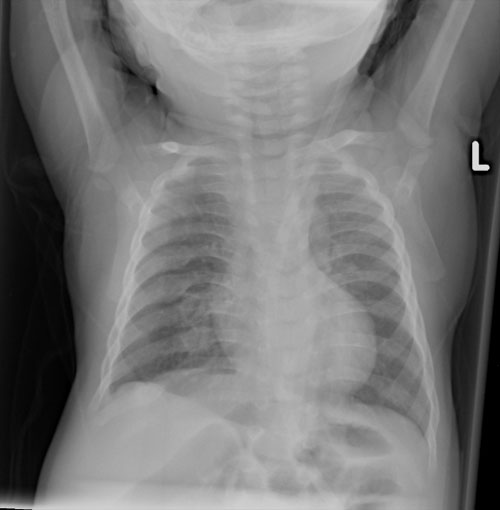A 4-month-old baby with respiratory distress is admitted to the hospital. A chest radiograph is obtained as part of the work up for respiratory distress.

Accessible Version
A chest radiograph of a child showing calcified areas on multiple posterior ribs.
True or False: Once the radiologist notifies the physician of record regarding the findings observed on this X-ray, the radiologist is exempt from further notification to child protective services.
◯
A. True
◯
B. False
True or False: Once the radiologist notifies the physician of record regarding the findings observed on this X-ray, the radiologist is exempt from further notification to child protective services.
◯
A. True
✓
B. False
The best answer is B
The chest X-ray shows multiple right posterior healing rib fractures. This finding is suspicious for child abuse. While rib fractures can rarely occur following vigorous chest physiotherapy, it should not be assumed that this is the cause of the fractures. This is particularly true in this case since the baby’s fractures show signs of healing, and therefore, the injuries are not likely to be related to the respiratory distress at the time of the current hospitalization.
Chapter 193 of the Laws of 2007 – Amendment to Section 413 of the NYS Social Services Law affects procedures for reporting in medical institutions, as well as schools or other institutions. This amendment recognizes that there are situations where there are multiple mandated reporters and states, "Mandated reporters who work for a hospital and through their work have direct contact with a child ...(with) reasonable cause to suspect abuse, must personally make a report." A radiologist is a mandated reporter, and as such, is legally mandated to report suspicions of abuse to the State Central Registry. Because there is immunity from liability, it is best to report suspicions even if they later prove to be erroneous.
In the case of this infant, because the radiologist is suspicious of abuse, he or she must determine whether a report has been or will be made. If no report has been made and there are no plans to report, the radiologist is personally responsible for making a report to the State Central Registry. The radiologist cannot call the hotline to confirm that a call was made. He or she should contact the referring physician to confirm that a call was made and to relay the information regarding the findings. The radiologist should also document the suspicions in the written radiology report. In most cases, it will be rare for a radiologist or a referring subspecialist (for example, the pulmonologist, unless he or she is also the physician of record) to have to file a report. Usually, discussion with the primary physician leads to appropriate action.
Once one mandated reporter has made a report, any other mandated reporters are not required to make a separate, additional report except under certain circumstances. These circumstances include situations where new information is revealed, a report is not accepted, or the mandated reporter has additional information that may change the course of events. An SCR (Statewide Central Registry) number is given when a hotline call is made. It is suggested that in situations with multiple mandated reporters that this number be documented in medical records to indicate that the responsibility to report has been met.
In a hospital setting, a social worker might be the most appropriate professional to assist with facilitating the call to the hotline and gathering information from all the mandated reporters. This person can also assist with the form DSS221A that must be filed within 48 hours of the call to the hotline.
Further Reading
- New York State Office of Children and Family Services Informational Letter - Guidance on Interpretation of Law on Mandated Reporters.
- New York State Office of Children and Family Services Summary Guide to Mandated Reporters in New York State.


